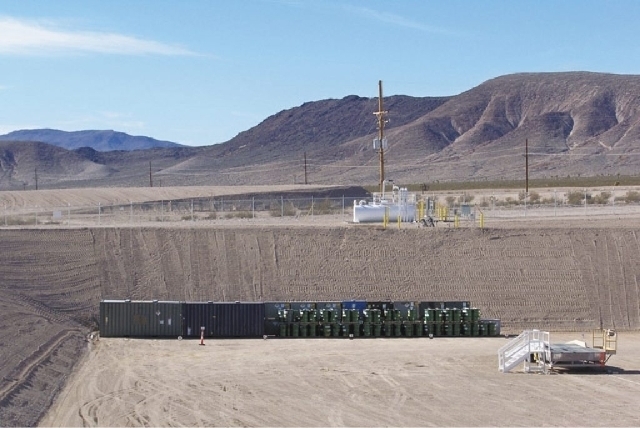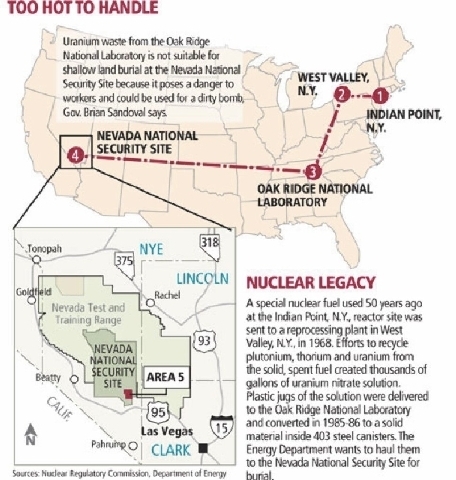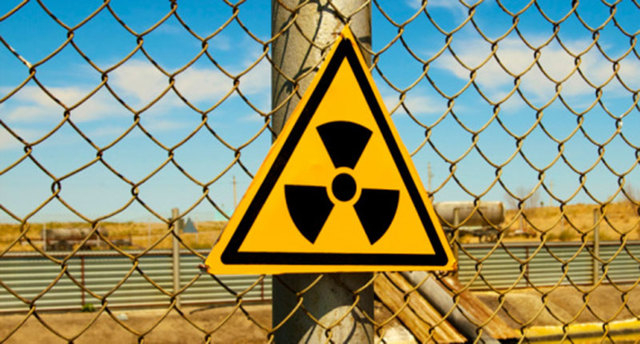DOE: Nuclear waste move to Nevada to start in 2014
Trucks hauling dangerous uranium waste from Tennessee for burial in a landfill at the Nevada National Security Site will start rolling early next year despite objections from Gov. Brian Sandoval, who is powerless to stop them, federal officials said Tuesday.
Department of Energy officials insisted the strategy will be safe despite questions about the suitability of disposing potent, highly radioactive nuclear material in trenches deeper than 40 feet in the southeast part of the former Nevada Test Site.
Kevin Knobloch, chief of staff to Energy Secretary Ernest Moniz, said Nevada cannot veto the disposal plan at the government’s self-regulated site, 65 miles north of Las Vegas.
That leaves the state — if it chooses — with the possible threat of legal action or intervention by Nevada’s congressional delegation led by Senate Majority Leader Harry Reid, D-Nev., as remedies for DOE’s plan.
In the face of opposition from Sandoval, Knoblach said the DOE has pledged to “work very closely with state and local authorities to make sure we are listening to concerns, answering questions, sharing information.”
Knobloch and other DOE officials spoke to reporters as the DOE prepares for tonight’s public meeting at Cashman Center. That meeting will precede a second one Thursday in Pahrump to discuss the plan. Both meetings are scheduled from 5 to 9 p.m.
The DOE planned to start shipments last spring but put the campaign on hold when it became publicized and caused Nevada officials to declare a new uneasiness over them. Among other things, the waste is an unusual form that raised questions whether it fits the criteria to be buried at the security site alongside other contaminated debris from government cleanups.
For a state that fought tooth and nail against the proposed high-level nuclear waste repository at Yucca Mountain, the prospect for another type of highly radioactive waste to be buried in the state also was unsettling to environmental activists and some leaders.
If Nevada failed to put a foot down about the uranium material, or at least try, what other forms of nuclear waste might the government look to ship to the Silver State?
Sandoval and Moniz this summer assigned aides to meet on uranium waste and other matters that have created scratches in the long relationship between Nevada and the federal government over operations of the national security site.
The group held its initial meeting in Washington last month, but not all could attend because of the federal government shutdown. Officials from both the DOE and the state have expressed hope the group might come up with accommodations that would smooth over differences on the disposal plan.
“Governor Sandoval’s views on the proposed U-233 waste shipment remains unchanged,” spokeswoman Mary-Sarah Kinner said Tuesday. ”That said, the U.S. Department of Energy retains the authority to dispose of low-level nuclear waste at the Nevada National Security Site, which is why the working group is so important to the state and other stakeholders.”
The DOE’s plan calls for moving 403 canisters of nuclear-power fuel remnants to the Nevada site from Tennessee’s Oak Ridge National Laboratory.
The once-liquid waste from a 1960s reprocessing plant in upstate New York was solidified and baked inside steel canisters at the Oak Ridge lab, where it has been stored in a historic Manhattan Project building since the mid-1980s.
The canisters containing a ceramic mixture of three uranium isotopes — U-233, U-235 and U-232 — will be transported to Nevada National Security Site as part of an environmental cleanup of the Tennessee site. DOE officials say they prefer to begin the shipments early next year.
Mark Whitney, environmental cleanup manager at Oak Ridge, said between 50 and 100 shipments would be made over a period of 18 months to three years.
In Tuesday’s conference call with reporters, Whitney acknowledged that the majority of the waste material, 76 percent, is uranium-235, the same atom-splitting isotope that has been used in some nuclear bombs that were tested during the Cold War at the Nevada Test Site.
He said 10 percent of the waste consists of another atom-splitting isotope, uranium-233, though the cocktail of uranium waste is commonly referred to as U-233. Uranium-233 is also a nuclear bomb material and will be around at least 159,200 years before half of its radioactive punch decays to safer levels.
Despite the atomic bomb materials that DOE officials say are benign because neutron-absorbing ingredients have been mixed to reduce the risk of an accidental nuclear reaction, Nevada officials have said a greater concern is an impurity that in the hands of terrorists could be turned into a “dirty bomb.”
The impurity is the other isotope, uranium-232. Though it has a much shorter half-life, roughly 70 years, waste containing it requires heavy shielding and must be handled using remote-controlled cranes.
And as it decays, U-232 creates a new menace: thallium-208. That offspring emits short-lived but intense, deadly gamma rays that are, in a nutshell, “radiotoxic” — or biologically harmful to the human environment. Anyone tampering with the uranium-tainted waste in the canisters to extract material for a dirty bomb would risk death from gamma ray exposure.
Because of the high percentage of atom-splitting bomb ingredients, the material should not be permanently buried as low-level waste in a landfill because it doesn’t meet Nuclear Regulatory Commission low-level radioactive waste guidelines, said Michael Voegele, former Yucca Mountain Project chief scientist who works as a consultant to Nye County.
Some critics have noted the DOE quietly changed its waste-acceptance criteria in May so that the Oak Ridge canisters could be disposed of as low-level waste that’s five times more radioactive than previously allowed.
The longevity of the landfill as compared to a more fully contained geologic repository for containing waste for 10,000 years while it decays to safer levels is also an issue. In the case of Yucca Mountain, scientists considered future climate changes and other factors such as increased rainfall and earthquakes that could compromise the repository’s ability to contain decaying, radioactive materials.
Frank Marcinowski, DOE’s deputy assistant secretary for environmental management, said the agency’s climate analysis shows there will be “no appreciable release” from the landfill before 10,000 years.



















